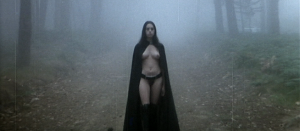A month or so ago I got a subscription to the horror movie channel Shudder. We saved money by Cutting the Cable Cord, but now are approaching the same budget by a-la-carting so many other streaming providers (“The tragedy of your times my young friends is that you may get exactly what you want.”). I subscribed to Shudder out of genuine interest in horror and indie horror, and the fact that it was only $5/month made me more pliable. Streaming services take note: $10/month seems to be the standard price so $5/month is an irresistible target. Go for the long tail.
So far on Shudder I’ve watched Frontier(s) (2007), It Stains the Sands Red (2017), and Daughter of Dracula (1972) (not Dracula’s Daughter from 1936, fwiw).

I dove into a few Jess Franco films back in November 2015 and I still value them for their inventive variety (he’s done ~160 films!): the three films I watched were of such wildly different styles that they were effectively from different directors. His film Female Vampire introduced me to the pre-Bram Stoker vampire story Carmilla (1871) and all of it’s variations since then. Daughter of Dracula is connected to that literary lineage, also known as the Karnstein/Karlstein vampire myth, and includes the Franco films along with Hammer films and an LGBT web series (see also this wonderful THE KARNSTEIN TIMELINE collection of all media Karnstein-related). They are all part of a larger style of lesbian vampire stories.
Although Daughter of Dracula was filmed in Lisbon (cf. Female Vampire filmed in moody and beautiful Madeira), I did not recognize the city that we had visited. Living in Midtown Atlanta I should know the radical differences that 40 years can impose on a city.

Daughter of Dracula has the softcore porn aspect of many of Franco’s films. The opening scene includes a woman, full frontal preparing for a bath, and the camera more than lingers. Other scenes I-kid-you-not dramatically zoom in to 1970s-era unshaven et ceteras. Whether this was titillating back then I’m not sure but it is incredibly non-sexual today. During one “lesbian” scene there was such an invasive soundtrack referencing show tunes, comedic, and dance styles, that the extended breast licking was completely unbelievable. And, yes, I typed “extended.”
Daughter of Dracula differed from the previous vampire film of his that I watched, Female Vampire. That one was more static and moody, expressing the lead’s curse more with lingering camera shots and frequent foggy, daytime scenes. Daughter of Dracula felt more conventional. Said daughter learns about her heritage as the local police attempt to solve a series of recent murders. Both films are worth a watch and would be good as a double-feature. Are you listening, Plaza Theatre?
